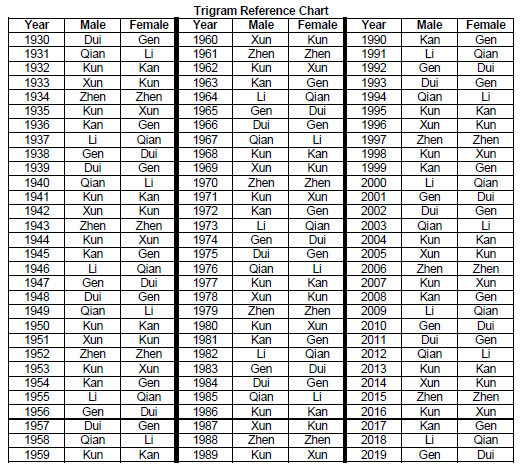Finding your Best Feng Shui Directions
Everyone asks us how to determine their favorable and unfavorble directions for sleeping, working, study, etc. Each person aligns with one of the 8 directions and can use four of the directions to their benefit. Below are some guidelines on finding out what your directions are.
First, Feng Shui is based on the Solar Calendar, not the Lunar Calendar. The commonly known “Chinese New Year” is typically the Lunar Calendar. Some forms of Chinese astrology are based on the lunar calendar, but Feng Shui is based on the sun, which influence our seasons and dictate our climates.
The Chinese hold February 4th as the “Spring Establishment,” or the time when the new solar year begins. If you where born before February 4th you belong to the prior year’ s trigram. If you are born on February 4th or 5th, you should check with 168 Feng Shui Advisors for the exact Trigram based on the time of your birth.
To find out how best to position yourself at home and at work, please find your Trigram based on your birth date. Then look below to determine your favorable and unfavorable directions.
Birth Year and Trigram Chart

Align yourself with your best directions:
Using the Chart below, find your Trigram. Then look at the directions across. These are your good to bad directions (from Left to Right). The second chart below shows the significance of these directions.
Ideally, you want to place your back to the A direction (receive support from this direction) and sleep with your head pointing to the D direction. The directions of A through D are beneficial and the directions of E through H are to be avoided. The D direction is your Trigram’s native direction. It is also your most comfortable direction. This is a good direction for sleeping or relaxing.
| Trigram | A | B | C | D | E | F | G | H |
| Chen | S | N | SE | E | SW | NE | NW | W |
| Sun | N | S | E | SE | NW | W | SW | NE |
| Li | E | SE | N | S | NE | SW | W | NW |
| Kun | NE | W | NW | SW | E | S | SE | N |
| Tui | NW | SW | NE | W | N | SE | S | E |
| Chien | W | NE | SW | NW | SE | N | E | S |
| Kan | SE | E | S | N | W | NW | NE | SW |
| Ken | SW | NW | W | NE | S | E | N | SE |
Interpretation of the Directions
| Direction | Interpretation | |
| A | Good Fortune and Great Fame | Best |
| B | Good Wealth and Helpful Friendship | ^ |
| C | Family Harmony and Good Public Relationship | ^ |
| D | Peace and Good Management | ^ |
| E | Arguments and Potential for Lawsuits | ^ |
| F | Misfortune and Malicious Influences Likely | ^ |
| G | Accidents, Disaster and Negative Influences | ^ |
| H | Unproductive Career, Poor Finances, and Robbery | Worst |
Do not take these as literal interpretations, but rather as indicators of the “potiential.” Remember that the area of qi you are in has an effect and that can be stronger than the directions. In other words, if you are in a good area of qi and oriented to the negative direction, the qi has a more direct effect on you so you will prosper.
Use this chart as a guideline to finding your ideal directions or areas and avoid orienting yourself to the negative directions or within negative areas. The study of Feng Shui is like an onion. You can peel away the layers one by one and discover that there are other influences on levels. Feng Shui is truly a lifelong study.
